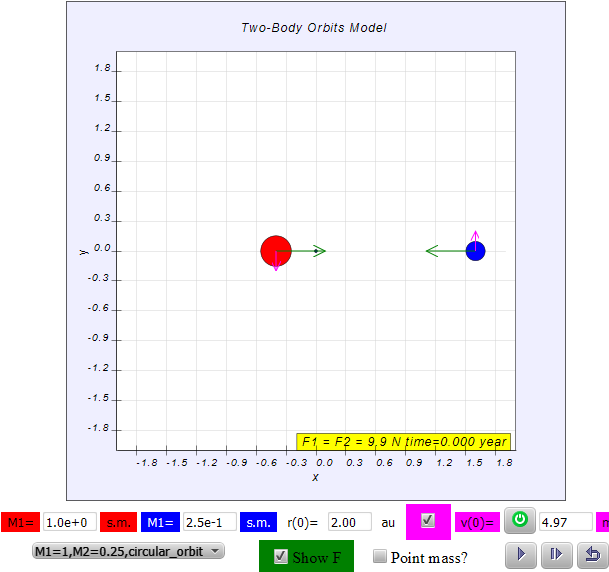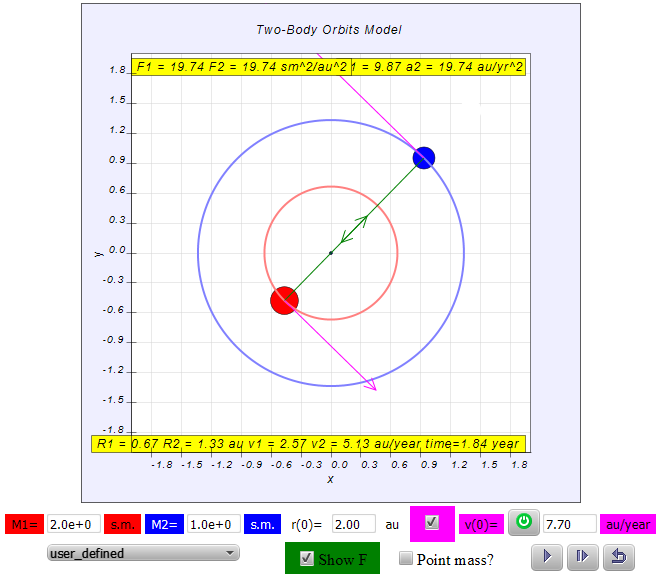 |
| http://weelookang.blogspot.com/2014/05/ejss-two-body-circular-orbits-model.html https://dl.dropboxusercontent.com/u/44365627/lookangEJSworkspace/export/ejss_model_TwoBodyOrbitswee/TwoBodyOrbitswee_Simulation.xhtml source: https://dl.dropboxusercontent.com/u/44365627/lookangEJSworkspace/export/ejss_src_TwoBodyOrbitswee.zip authors: Wolfgang Christian, this version by lookang author of EJS 5: Paco. |
Two Body Orbit Theory by Wolfgang Christian
Because two objects (e.g., a star and a planet) with massesis known.
Placing the center of mass (barycenter) at the (0,0) center of
the coordinate system, the ratio or the distance from the center
is inversely proportional to the object mass ratio
m1m2=r2r1
wherer=r1+r2
is the separation.
where
In other words, if m1
is twice as massive as m2 ,
then the two objects will be on opposite sides of the origin
and m1 will
be half as far from the origin as m2 .
This ratio relation is also observed when using a lever or seesaw to
balance two masses.
The elliptical motion of two gravitationally attracting objects
about their center of mass is a classical mechanics problem and
was first solved by Newton. This two-body problem
can be re-formulated as the motion of a single object (if you observe carefully, it is white
color of the model) with a mass
μ=m1m2m1+m2
that is attracted toward the origin and obeys Newton's second law:
F=μa=Gm1m2r2
Fx=μax=−xGm1m2r3
Fy=μay=−yGm1m2r3
Substituting for μ gives
the following differential equation for the separation
vector r .
a=G(m1+m2)r2
in x and y axis,
ax=−xG(m1+m2)r3
ay=−yG(m1+m2)r3
dxdt=vx
dydt=vy
dvxdt=ax=−xG(m1+m2)r3
dvydt=ay=−yG(m1+m2)r3
where
totalMass=redMass+blueMass=m1+m2
GM=G=4π2
rcubed=r3
The choice of units determines the numerical value of the gravitational constant G. In this simulation, we compute the orbit using time in Earth years and distance in Earth radii (astronomical units). Using these units, the value of
 |
| when |
 |
| when |
 |
| when |
 |
| when |
that is attracted toward the origin and obeys Newton's second law:
in x and y axis,
Ordinary Differential Equations:
where
The choice of units determines the numerical value of the gravitational constant G. In this simulation, we compute the orbit using time in Earth years and distance in Earth radii (astronomical units). Using these units, the value of
rather than the MKS value of
Motion of Mass 1 and 2
To get the motion of the 2 bodies, says call them body 1 and body 2 where
where
the velocities can be determined using the following
similarly for the acceleration,
similarly the forces,
EJSS Two Body Circular Orbits Model by Wolfgang Christian
The Two-Body Orbits JavaScript Model shows the motion of two objects (e.g., binary star or moon-planet system) interacting via Newton's law of universal gravitation. It is designed to teach physics, Earth science, and environmental science topics by showing the spatial path of objects around their common center of mass (barycenter). Default units are chosen for Earth orbit about our Sun so that the distance unit is one astronomical unit and the time unit is one year.Credits:
The Two-Body Orbits JS Model was developed by Wolfgang Christian using the Easy Java Simulations version 5 (EJS 5) modeling tool. Although EJS is a Java program, EJS 5 can create stand alone JavaScript programs that run in almost any PC or tablet browser.
Information about EJS is available at: <http://www.um.es/fem/Ejs/> and in the OSP ComPADRE collection <http://www.compadre.org/OSP/>.
Problem 1:
Example 1 (N84/P2/Q7) Binary StarsTwo stars of equal mass M move with constant speed v in a circular orbit of radius R about their common centre of mass. What is the net force on each star?
 |
| (N84/P2/Q7) Binary Stars |
A
B
C
D
E
Simulation Equivalent:
 |
| Example Simulation Equivalent
(N84/P2/Q7) Binary Stars Two stars of equal mass M move with constant speed v in a circular orbit of radius R about their common centre of mass. What is the net force on each star? http://weelookang.blogspot.com/2014/05/ejss-two-body-circular-orbits-model.html https://dl.dropboxusercontent.com/u/44365627/lookangEJSworkspace/export/ejss_model_TwoBodyOrbitswee/TwoBodyOrbitswee_Simulation.xhtml source: https://dl.dropboxusercontent.com/u/44365627/lookangEJSworkspace/export/ejss_src_TwoBodyOrbitswee.zip authors: Wolfgang Christian, this version by lookang author of EJS 5: Paco. |
Working
Using Newton's Gravitational Law in Circular Motion
Answer is A.
Problem 2:
Example 2 (N09/I/16) Binary StarsTwo stars of mass M and 2M, a distance 3x apart rotate in circles about their common centre of mass O.
The gravitational force acting on the stars can be written as
What is the value of k ?
A 0.22
A 0.22
B 0.50
C 0.67
D 2.0
Simulation Equivalent:
 |
| (N09/I/16)
Binary Stars Two stars of mass M and 2M, a distance
3x apart rotate in circles about their common centre of
mass O.The gravitational force acting on the stars can be
written as What is the value of k ? http://weelookang.blogspot.com/2014/05/ejss-two-body-circular-orbits-model.html https://dl.dropboxusercontent.com/u/44365627/lookangEJSworkspace/export/ejss_model_TwoBodyOrbitswee/TwoBodyOrbitswee_Simulation.xhtml source: https://dl.dropboxusercontent.com/u/44365627/lookangEJSworkspace/export/ejss_src_TwoBodyOrbitswee.zip authors: Wolfgang Christian, this version by lookang author of EJS 5: Paco. |
Working
Using Newton's Gravitational Law in Circular Motion
F=GM1M2(R1+R2)2=G2MM(3x)2=29GMM(x)2
Answer is A.
"M1=5.9726,M2=0.073242,Approximate_Earth_Moon"
 |
| "M1=5.9726,M2=0.073242,Approximate_Earth_Moon"
as suggested by soo kok http://weelookang.blogspot.com/2014/05/ejss-two-body-circular-orbits-model.html https://dl.dropboxusercontent.com/u/44365627/lookangEJSworkspace/export/ejss_model_TwoBodyOrbitswee/TwoBodyOrbitswee_Simulation.xhtml source: https://dl.dropboxusercontent.com/u/44365627/lookangEJSworkspace/export/ejss_src_TwoBodyOrbitswee.zip authors: Wolfgang Christian, this version by lookang author of EJS 5: Paco. |
Changes made by lookang include
- added the invisible mass for which the binary system's motion are derived from.
- added the velocities v1x, v1y and v2x v2y
- added velocities checkbox
- added units labels clearly showing units a.u. and year
- added combo drop-down list for ease of use
- added numerical values for sense making such as F1, F2, a1, a2, R1 and R2 v1 and v2
- made forces a bit longer to see more clearly
